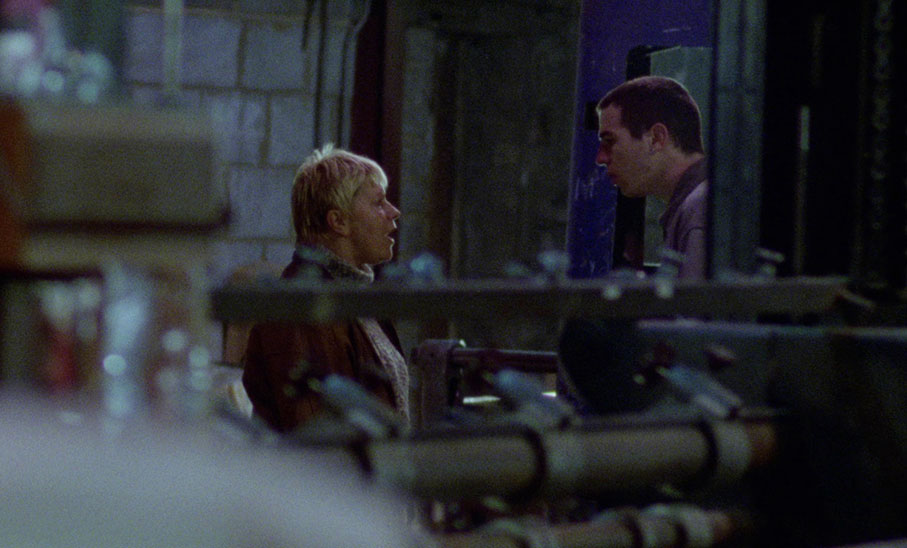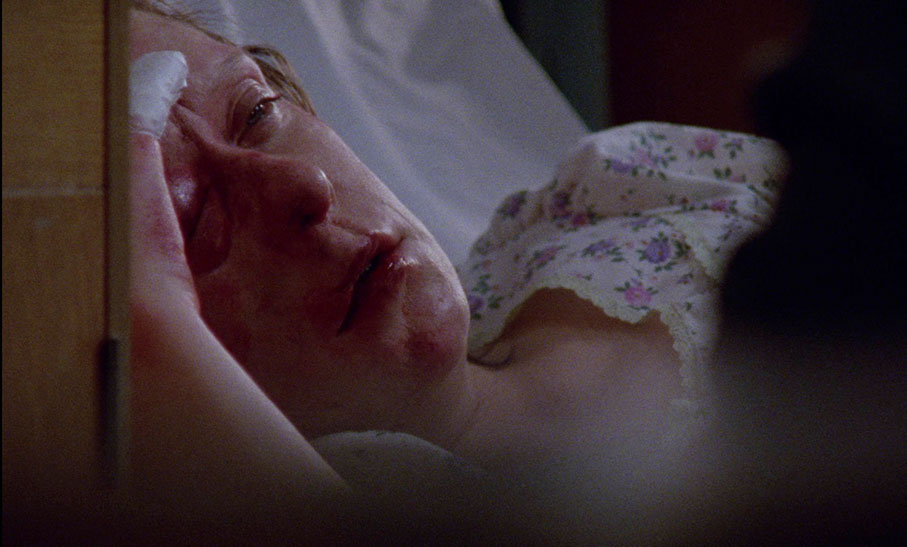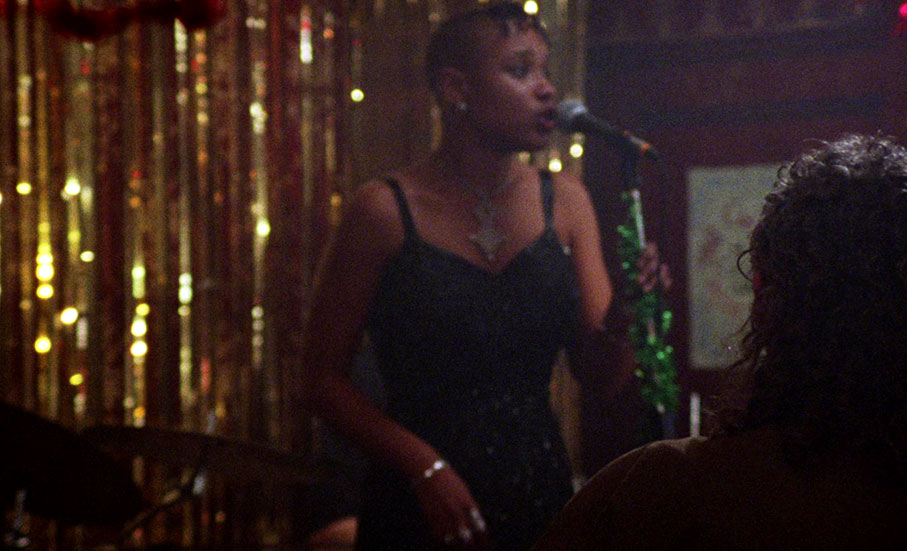|
New Cross, South London, the mid 1990s. Billy (Charlie Creed-Miles) lives with his sister Val (Kathy Burke) and her husband Ray (Ray Winstone). Also in the household are Val and Billy's mother Janet (Laila Morse) and grandmother Kathy (Edna Doré). Billy has been stealing money from Ray for drugs; Ray throws him out of the house. Most of them live in fear of Ray's violent outbursts. He and Val have a daughter, Michelle (Leah Fitzgerald) and Kathy is pregnant again.
Narrative cinema is a century and a quarter old now, and there are filmmakers (writers, directors or both) who have maintained a prolific output. Case in point, Ingmar Bergman, of whom I've reviewed so far twenty-four feature films in three sets, with one final set due in January 2023. Yet there is another end to this scale: directors whose output is valuable for being sparse. In his interview of Gary Oldman on this disc, Geoff Andrew cites Victor Erice, best known for The Spirit of the Beehive (1973), who has followed it at the time of writing with just two feature films, one of them a documentary, plus seven short films throughout his career. An even sparser output would be a single feature film, such as Charles Laughton, whose only directing credit was The Night of the Hunter (1957) and a masterpiece. Gary Oldman is another example. As with Laughton, his main job is as an actor, with an Oscar for Darkest Hour in 2017. Nil by Mouth, first released in 1997 and here restored for its twenty-fifth anniversary, remains his only film as director, one in which he does not act. (Having said that, it's his voice, offscreen, as a barman in the opening scene, and he can be seen coming out of a phone box fifty-two minutes in.) For whatever reason, and the fact that his film was a box-office flop was certainly one of them, Laughton didn't direct again. Nor has Oldman, though at age sixty-four as of this writing he certainly has the time still. He goes into this more in the extras.

I'm not of the social background depicted here (and I'm six years younger than Oldman) but I don't doubt the film's accuracy at depicting a time and place, namely Oldman's native South East London, and that accuracy is to the film's favour. The emphasis is on the people rather than the place (though the former are no doubt shaped by the latter) and the film is an ensemble piece. It's an ensemble piece centred on one particular family, though Oldman wishes to make it clear that Ray and Valerie are not stand-ins for his own parents. Their story, which includes an almost-unbearable scene of domestic violence, ties in to an overall theme of toxic masculinity as it develops and is reinforced, and female survival within it and resistance to it. But stories like these no doubt happened in other households where he grew up. He states that if he does have a standin in this film, it's the youngest member of the family, Michelle. This is not the first time a male director has used a young girl as his surrogate in an on-screen family group – Bergman, to mention him again, has done the same in his time. (In Fanny and Alexander, he's more aligned to the former than the latter.) But there's no doubt that there is something cathartic about this film, which may be one of several reasons why Oldman has not followed it up.
While his acting career developed, Oldman began working on the script for Nil by Mouth, at first notes, then more development of scenes. He showed this to friends and colleagues, some of whom recoiled at the pervasive profanity in the script. (The final version still apparently holds the record for most uses of the word "cunt", eighty-two of them (count them), along with four hundred and twenty-eight "fucks" or derivatives.) Luc Besson, for whom Oldman had played the villain in Léon, read the script and agreed to put up some of the budget, though it's at some distance from the films he made himself. (Besson apparently was a little puzzled by the script, expecting it to be funnier. No doubt this is down to national/linguistic differences as there is a lot of at times very dark humour here, but maybe London and Paris are divided in more ways than the different languages they speak.) The rest of the budget was put up by Oldman: as he says, many actors put their money into cars or artwork, but he hadn't, so in a way Nil by Mouth was his Lamborghini.
As I say above, the film is more of an ensemble piece, with different characters coming to the fore at different times. Stylistically, Oldman borrows from a few places, with John Cassavetes being an acknowledged influence. Another would be Robert Altman, with much use of long lenses and zooms, though generally not as much improvisation than Altman might have encouraged. (None at all, in fact, except in rehearsals.) That said, he gives his cast a lot of space. Also, Altman would most likely have shot in Scope, and Oldman and his DP Ron Fortunato uses Super 16mm, a single camera throughout, the film stock blown up to 35mm for cinema release, and very grainy it is. The music score is by Eric Clapton, though it's sparely used.

Nil by Mouth premiered at Cannes on 8 May 1997. Oldman and several of the male cast were there, but Kathy Burke wasn't. When word broke that she had won Best Actress, Besson arranged for her to be flown over to Cannes in his private helicopter, as her passport was out of date. Along with a British Independent Film Award for the same role, it remains the only major film award she has ever won. Although released by a major (20th Century Fox) in the UK, Nil by Mouth had a relatively "specialised" release, which meant that many of the people the film was made about and for were unable to see it, in a cinema at least.
Nil by Mouth is released by the BFI in a two-disc Blu-ray edition, both discs encoded for Region B only. The film still has, and earns, the 18 certificate it had on original release. Children has a 15 certificate.
As mentioned above, Nil by Mouth was shot on Super 16mm, and has been restored at 4K from the original 16mm negative (A and B rolls) and a 35mm interpositive. The aspect ratio is the intended 1.66:1 (though I suspect many British cinemas would have cropped the image to 1.75:1 or 1.85:1). While Oldman and Fortunato have gone what might look like maximum fly-on-the-wall realism, with grain to match, there's an aestheticism at work too, in the colours, in the costume and production design.
The soundtrack comes in two flavours: DTS-HD MA 5.1 and LPCM 2.0. There isn't a great deal to choose between the two sound mixes, as neither go in for elaborate sound design, and if dialogue overlaps we always hear what we need to. Hard-of-hearing subtitles are available on the main feature and on Children. There is an English audio-descriptive track as well.
As well as the feature and the commentary, Disc One includes the deleted scenes and the trailer. The remaining extras are on Disc Two.

Audio commentary by Gary Oldman & Douglas Urbanski
Newly recorded for this release, at first this comes over as a Gary Oldman solo commentary, as Urbanski doesn't speak for nearly fifteen minutes. A quarter-century on, they talk about the look of the film and the benefits of shooting in Super 16mm, and members of Oldman's family as they make their appearances. It doesn't overlap too much with both men's separate interviews on this disc.
Deleted scenes (39:27)
Three deleted scenes, all from timecoded video, but no they don't average thirteen minutes each. We do instead get repeated go-throughs of each scene. Oldman explains further in the booklet, including why each one had to go. The scenes are "Where's My Coke?", "Police Interview" and "Damp Walk Home".
Reissue trailer (1:37)
The original isn't here to compare it with, but needless to say this time round they have some critical raves and a 4K restoration to trumpet. On to Disc Two.
Interview with Gary Oldman (50:56)
All of the five interviews in this set are new. The first three were filmed at the BFI Southbank in London and have Geoff Andrew as the interviewer, the first and by far the longest with Gary Oldman. Inevitably there's overlap with the commentary track and Andrew feeds us with information we might not know – that he saw the film very early on and his was one of the first rave reviews. On this disc, Oldman tones down comments he's made elsewhere that he felt he was being sabotaged when the film was in production (if you believed the naysayers, he didn't know what he was doing, the film didn't cut together, it was a disaster) but he does mention that Elaine May did watch the film and offered him four pieces of advice. He took three of them, declining one as an assertion of his own authority as director. He also talks about the films he hasn't been able to make in the twenty-five years since, most notably a biopic of Eadweard Muybridge.

Interview with Ray Winstone (22:04)
Interviewed by Andrew, Winstone believes (correctly) that the part of Ray, even down to the character name, was largely written for him. It's hard to think who else at the time could have played the role. However, Oldman and Winstone didn't know each other, though they had in common the fact that that they'd both worked for Alan Clarke, and first met at Clarke's funeral. He compares the film with another role of his, a debut (and only) film by a fellow British actor as actor, Tim Roth's The War Zone, made two years later.
Interview with Douglas Urbanski (15:34)
Urbanski talks about how he met Oldman, hitting it off with him immediately, and became and remains Oldman's producer partner. He doesn't pretend to know what is going on in Oldman's head, but sometimes, he says, talent has to be trusted. He distinguishes between interpretative artists (actors, musicians etc) and originating artists (such as writers, directors) and in this case Oldman's urge to be other than his usual role for a change. He does regret that the film got an arthouse release so that those whom the film was about didn't get to see it.
Interview with Charlie Creed-Miles (27:53)
Interviewed at the BFI Southbank, though this time speaking to camera, Creed-Miles talks about how he became an actor. He auditioned for Nil by Mouth and thought that he'd wrecked his chances due to sheer nervousness. He looks back fondly on the production. He notes that Ray Winstone, in mid demented screaming fit, never left a mark on him, while Kathy Burke slapped him once on the back and did leave a mark.

Interview with Sue Jones (16:02)
Jones's interview takes the form of onscreen text questions, which Jones then answers to camera. Nil by Mouth was her second film as casting director, following Steven Berkoff's Decadence. Asked to work on Nil by Mouth, she talks about how she found some of the younger actors. Soon word got around and people were, in the title of this interview, "queueing up for any role". Auditions were held at the Anna Scher Children Theatre, which is where they found Charlie Creed-Miles.
Mother (7:20)
This is what remains of Oldman's project to make a film about his mother, documenting the stories she told – born in London and evacuated to Cardiff in the War – while he had the opportunity. We see seven minutes of footage of her walking down the streets local to herself. This was shot in black and white and is in an aspect ratio of 1.85:1.
Children (46:13)
Terence Davies's film, long enough by some definitions to be its own short feature (mid-length film, if you prefer), comes in somewhat from left field as an extra on this disc. Written when Davies was a student and made in 1976 It's another evocation of its creator's childhood, but unlike Nil by Mouth it's the start of a trilogy, followed by two further shorts just under half an hour each: Madonna and Child (1980) and Death and Transfiguration (1983). Or even a trilogy that's the first part of a larger trilogy of Davies's pictures of his own life, as it was followed by Distant Voices Still Lives (made as two mid-length films later joined together, released as a single feature in 1988) and The Long Day Closes (1992). Children was shot in black and white 16mm. Davies's lead character, Robert Tucker, is semi-autobiographical but while Davies found a way out, into filmmaking, Tucker doesn't. For most of this first film, he's a teenage boy (Philip Maudesly), but there are – in what would become a Davies trademark – flashforwards to Robert in his early twenties (Robin Hooper). There's little plot, more a series of character vignettes, held together by music more than narrative logic. Quiet and sensitive, close to his mother, Robert is bullied at school and called a "fruit". Robert has early signs that he is gay, when he watches a man (played by a young Trevor Eve) have a shower after a swimming lesson. Onetime Liver Bird Elizabeth Estensen appears as a nurse.
The whole of the Terence Davies Trilogy has been released on DVD by the BFI, but not on Blu-ray. What the (I suspect, commercial) likelihood of it seeing an upgrade, now that nearly half of its running time has turned up as an extra on another release, remains to be seen.

Galleries
Stills (2:45), Production Materials (6:02)
Two self-navigating galleries. The latter includes pages from Gary Oldman's annotated shooting script.
Booklet
The BFI's booklet, included in the first pressing only, runs to seventy-six pages plus the covers. It begins with a two-paragraph introduction by Oldman, before moving on to "Returning to Nil by Mouth" by Douglas Urbanski. Unusually, he begins in the present day, attending a screening with Oldman partway through the film's restoration process. As in his interview, Urbanski says that he doesn't always know how his business partner ticks.
Next is Kat Ellinger's "I Did It Because I Love You: Violence and the Working Class Man in Nil by Mouth" and in that title is a different perspective to many writings on this film: not so much that of a woman as there have always been female film critics, but a working class woman in what is overwhelming a middle-class (and upwards) profession. But it's a valuable one, talking about violence, domestic violence very much included, in working-class men and often directed at women. Ellinger finds the film hard to watch, but it is also in her words an "avenue of catharsis" and a rare look at the roots of such violence. Another example she gives is the New Zealander film Once Were Warriors. In working-class communities the world over, violence, its threat and the threat of its escalation, and being seen as "hard" is a means of survival, and add alcohol or other drugs to the mix. And this does not just affect men, it affects the women in their lives too. Often the target of the violence, the women still have to hold their families together. A very personal and valuable essay.
Interviewed by Lou Thomas, Gary Oldman remembers the Nil by Mouth shoot, with more emphasis than usual on shooting in Super 16mm and one of the few pieces I've read recently on the work of the focus puller. This is followed by another interview of Oldman, by Geoff Andrew from 1997. Then an interview, by Nick James, of another underrated crew member, production designer Hugo Luczyc-Wyhowski. The DP talks about how he was able to move away from the standard look and sound of historical drama. Oldman and he used a yellow tone with a few, but not many, bright colours.
"The Inspirations Behind Nil by Mouth", by Philip Kemp, takes the form of an interview with Oldman, who goes through his various influences. Top of the list given the country he comes from, would be the social realism of British directors like Tony Richardson, Ken Loach, Alan Clarke and Mike Leigh. (In fact, Oldman has worked with the latter two.) Then there was Pier Paolo Pasolini, via his then wife Isabella Rossellini. And John Cassavetes: Oldman and Ron Fortunato watched The Killing of a Chinese Bookie, and Oldman goes into detail about the use of colour in it, especially the ending.
Finally, "Sole Credit" by Jason Wood, which explores the phenomenon of the One Film Wonder: director's who make just the one feature. In 2018, at Manchester's HOME, Wood programmed just such a season and some of the wide-ranging titles are listed – not just first and only features, but ones which "managed to craft something arresting, or in some cases spectacular". The booklet continues with Oldman's notes on the deleted scenes, full film credits and notes on and credits for the extras, the notes for Children by Terence Davies and reprinted from a Sight & Sound interview with Jennifer Howarth.
Nil by Mouth caused a considerable stir on its release. Twenty-five years later, the dust may have settled a little, but it remains a raw, vital film of its time, particularly as Gary Oldham has yet to follow it up. No complaints about an excellent BFI release.
|